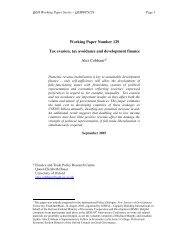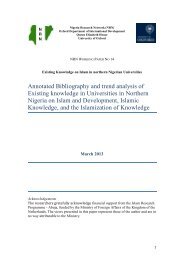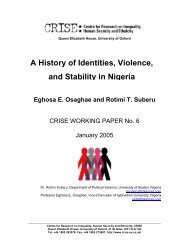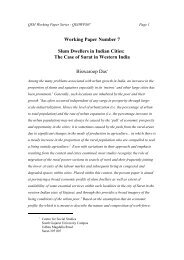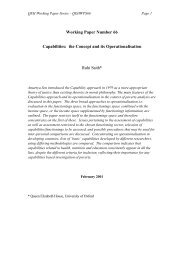Acute Multidimensional Poverty: A New Index for Developing ... - OPHI
Acute Multidimensional Poverty: A New Index for Developing ... - OPHI
Acute Multidimensional Poverty: A New Index for Developing ... - OPHI
You also want an ePaper? Increase the reach of your titles
YUMPU automatically turns print PDFs into web optimized ePapers that Google loves.
<strong>Acute</strong> <strong>Multidimensional</strong> <strong>Poverty</strong>: A <strong>New</strong> <strong>Index</strong> <strong>for</strong> <strong>Developing</strong> CountriesAlkire & SantosFigure 18: Summary MPI and income poverty estimates by UN regionsRegionPopulationin theregion(millions)Regional H(Proportion) Regional ARegionalMPIMPI poorpopulation(millions)$1.25/daypoor(Proportion)$1.25/daypoorpopulation(millions)$2/day poor(Proportion)$2/daypoorpopulation(millions)Central and Eastern Europe and theCommonwealth of Independent States (CIS) 400 0.030 0.421 0.013 12.2 0.055 22.0 0.098 39.4Latin America and Caribbean 490.8 0.104 0.462 0.048 51.0 0.074 36.5 0.150 73.7East Asia and the Pacific 1867.7 0.137 0.465 0.063 255.0 0.173 323.7 0.385 719.9Arab States 217.5 0.179 0.506 0.090 38.9 0.031 6.8 0.144 31.3South Asia 1543.9 0.547 0.532 0.291 843.8 0.402 620.3 0.740 1143.1Sub-Saharan Africa 710.4 0.644 0.582 0.375 457.5 0.520 369.5 0.730 518.3Total 104 countries 5230.3 0.317 0.532 0.169 1658.3 0.264 1378.8 0.483 2525.7Composition of MPI by Region. A natural question is whether the composition of poverty variesacross regions of the world to identify whether deprivation in a particular dimension is more acute incertain regions than in others. It is important to note that this analysis needs to consider both therelative contribution of each dimension to overall poverty as well as the absolute levels the MPIpoor experience in each dimension. All the figures mentioned below are contained in Tables 1.4-1.6in Appendix 1.1) South AsiaIn terms of human lives, South Asia has the world’s highest levels of poverty. Fifty-one percent ofthe population of Pakistan is MPI poor, 58 percent in Bangladesh, 55 percent in India, and 65percent in Nepal. In these four countries, the poor are deprived on average in more than half of the(weighted) indicators. In India, Bangladesh, and Nepal, deprivation in living standard is the highestcontributor of poverty, followed by health and education. In Pakistan the contributions are fairlysimilar (note that Pakistan did not have in<strong>for</strong>mation on nutrition). Sri Lanka is the only one of thefive countries we consider in this region that has low poverty estimates, with only 5 percent of MPIpoorpeople. The headcounts of the other four countries are relatively more uni<strong>for</strong>m than in otherregions. It is worth noting that water has low deprivation levels among the MPI poor in thesecountries (the highest being 14 percent in Nepal). Also, electricity has a low deprivation rate amongthe MPI poor in Pakistan (9 percent). However, deprivation in the other living standard indicators(and in electricity in India, Bangladesh, and Nepal) range from 26 percent to 63 percent, beingparticularly high in Nepal. Deprivation rates in the two health indicators are also high: 30 percent inPakistan and Nepal are poor and live in a household where at least one child died; this rate is 24percent in Bangladesh and 23 percent in India. Deprivation in nutrition of children and women ishigh, signaled by the fact that 40 percent of people in Nepal and 39 percent in India live in a poorhousehold where at least one child or woman is undernourished. This rate is 37 percent inBangladesh (there are no figures <strong>for</strong> Pakistan). Although education is the lowest contributor topoverty, deprivation rates are still high: between 17 percent and 29 percent of people in these fourcountries are poor and live in a household where no one completed five years of education. Thirtyfourpercent of the poor in Pakistan, 25 percent in India, and 15 percent in Nepal live in ahousehold where one or more children are not attending school. It is worth noting that inBangladesh only 9 percent of people live in poor households with children not attending school.Note that these country averages hide a huge diversity. In Section 4.4 below we decompose India’spoverty by state and find headcounts ranging from 14 percent to 81 percent.www.ophi.org.uk July 2010 46



